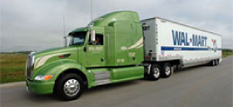| |
|
| |
|
 |
Supply
Chain by the Numbers |
| |
|
| |
- March 9, 2023
|
| |
|
| |
|
| |
|
| |
It will be awhile before eTrucks are Widespread, CEO Says; Amazon Closing Many Go Stores; Breakthrough in Trailer Loading Techology? Lowes Takes a Different Approach to DC Strategy |
| |
|
| |
| |
| ac |
| |
2045 |

|
Perhaps surprisingly, that is the earliest that heavy duty electric trucks would be widely available and adopted. That according to engine maker Cummins’ CEO Jennifer Rumsey in her keynote address to the annual Green Truck Summit on March 7 in Indianapolis, as reported on the truckinginfo.com web site. Rumsey added that trucking’s on-going energy transition “will unfold with different technologies for different applications, which means there will be no one solution.” She cited the technologies that will be in play over roughly the next 30 years to decarbonize transportation as including clean diesel, natural gas, propane to battery-electric, hydrogen, and fuel cell powertrains. She also made a point of stressing that advances along these pathways to zero-emission commercial vehicles will overlap and proceed at varying paces.
|
|
|
|
| |
| |
|
|
|
| Perhaps surprisingly, that is the earliest that heavy duty electric trucks would be widely available and adopted. That according to engine maker Cummins’ CEO Jennifer Rumsey in her keynote address to the annual Green Truck Summit on March 7 in Indianapolis, as reported on the truckinginfo.com web site. Rumsey added that trucking’s on-going energy transition “will unfold with different technologies for different applications, which means there will be no one solution.” She cited the technologies that will be in play over roughly the next 30 years to decarbonize transportation as including clean diesel, natural gas, propane to battery-electric, hydrogen, and fuel cell powertrains. She also made a point of stressing that advances along these pathways to zero-emission commercial vehicles will overlap and proceed at varying paces. |
|
|
|
| |
| |
6 |
|
That’s how many new import warehouses home products retailer Lowes will have after it opens a new facility soon in in Nanticoke, PA, according to an article this week in the Wall Street Journal this week. Lowe’s uses these warehouses to serve as storage facilities for offseason goods, a strategy the home-improvement retailer says will help it more efficiently distribute its inventory. The facilities are part of a broader $1.7 billion investment Lowe’s has been making in its supply chain to fill on-line orders faster. That has included adding ecommerce fulfillment centers for on-line orders. However, while many other retailers have focused on building those types of DCs to speed up order fulfillment in a move away from storing inventory, Lowe’s has also invested in new import distribution centers across the country that stow products such as seasonal and outdoor living items until they are in demand. “With our old model, we were locked in a fixed route from a distribution center to a store,” Don Frieson, executive vice president of supply chain at Lowe’s, said in an investor day presentation in December. “Now, we have increasing flexibility to flow product from whatever facility makes the most sense based on product availability and route efficiency.” By waiting to send merchandise to stores until it is needed, Lowe’s said it can free up capacity in its other logistics facilities and reduce the number of items it has to mark down in stores when inventory is sitting in a place where there isn’t demand for it. |
| |
| |
| |
| |
| |
|
|
|
| |
 |
 |
| |
 |
![]() |
 |
|
| |
 |
Feedback |
|
|
|
![]()
|
No Feedback on this article yet.
|
|
![]() |
|
|
|
![]() |
 |
![]() |
 |
|
| |